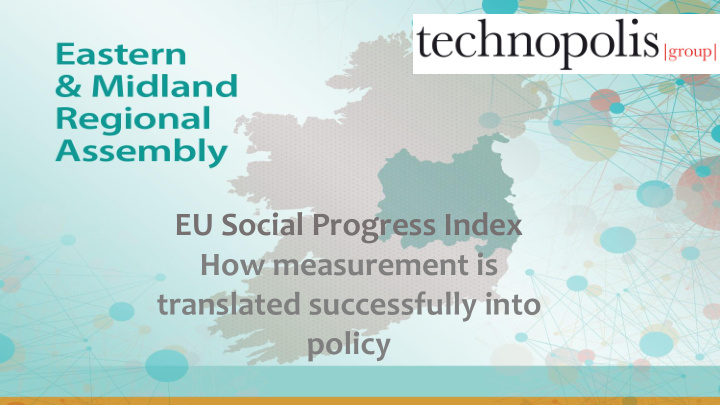



EU Social Progress Index How measurement is translated successfully into policy
How does EMRA enable regional development; WHA T WEDO? WHAT WEDO? 13 Strategic Planning • Make policy – new Regional Spatial and Economic Strategy Enabling (RSES ) • Provide oversight – statutory observations on local Regional Planning & authority development plans and variations Sustainable Development EU Affairs • Manage funds – Regional Operational Programmes and Monitoring Committees • Provide supports – Committee of the Regions and Irish Regions Office in Brussels Effectiveness in Local Government • Promote co-ordination – between EU/ National/ Regional and local governance • Develop knowledge – Research and evidence base for implementation and monitoring
Regional Spatial and Economic Strategy 2031 The need to enhance climate resilience and to accelerate a transition to a low carbon society recognising the role of natural capital and ecosystem services in achieving this. Regional Strategic Outcomes aligned with UN, EU and NPF
Issues Paper • Initial consultation period between 20 th November, 2017 and 16 th February 2018 • High level document to inform submissions and frame debate www.emra.ie/rses • Regional profile and evidence baseline informed the identification of strategic issues and key questions www.emra.ie/maps
Focus of study • Environment sub-component of Foundations of Wellbeing EU-SPI focus • Unsure of the EU- SPI’s Environmental Quality indicator • Ireland still faces challenges or EU infringements in implementing a number of directives. • The areas where compliance needs to improve include Drinking Water, Urban Waste Water Treatment, River Basin District Plans and Special Areas of Conservation • In-depth analysis of the Environmental Quality component of EU-SPI
Environmental Quality component EU-SPI • In-depth analysis of the Environmental Quality component of EU-SPI • Policymakers needed to go into much more details than the NUTS2 data to draft the RSES. • However, the EU-SPI provides a different type of information in that it allows a comparison with other regions • In our context the EU-SPI does not give such detailed data that it can be used to run a specific policy • EU-SPI useful at the strategy-making stage of the policy-making cycle
Case Studies
Usefulness of the EU-SPI • EU-SPI can draw attention to the social/environmental areas where the region is underperforming • It is a benefit that the EU-SPI is aligned (conceptually) with some SDGs • Ease of communicating with the public - EU-SPI could contribute showcase the role of regions. • EU-SPI could be a means for the region or other actors to receive EU funding for specific weaknesses.
Assessment of the EU- SPI’s data • The scorecard allows to see the main issues. The stakeholders found it very well presented • Environmental indicators do not cover sufficiently the local information, e.g wastewater treatment is very local-based, similarly air stations tend to be set in urban areas • The foreseen timeliness of about 2 years is considered good by the policymakers
Suggested improvements • Different indicators related to the quality of the environment in Ireland • There are better robust data available • Over- reliance on self-reported indicators • Suggested indicators include: wastewater treatment, air- borne nitrates, the share of green areas in the region, access to open spaces and parks and the share of the region dedicated to natural habitat, biodiversity indicators, indicators related to commuting. • Better visualization e.g download maps and infographics
Recommend
More recommend